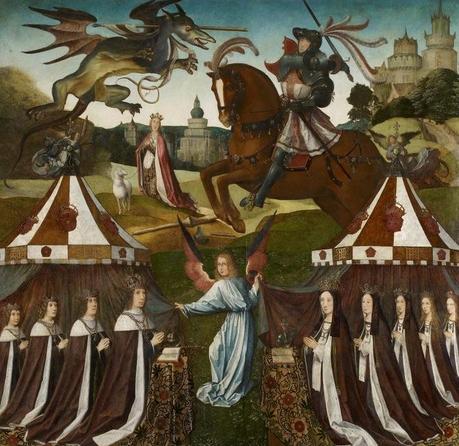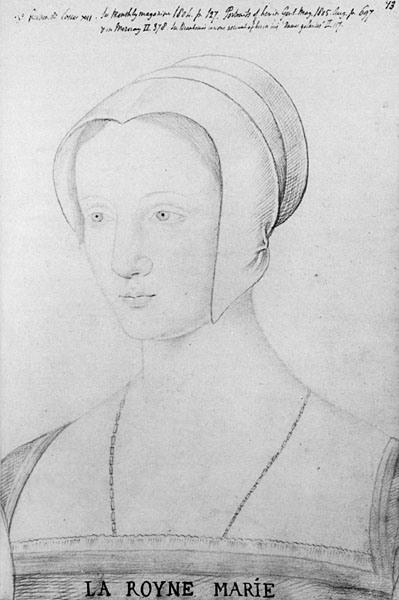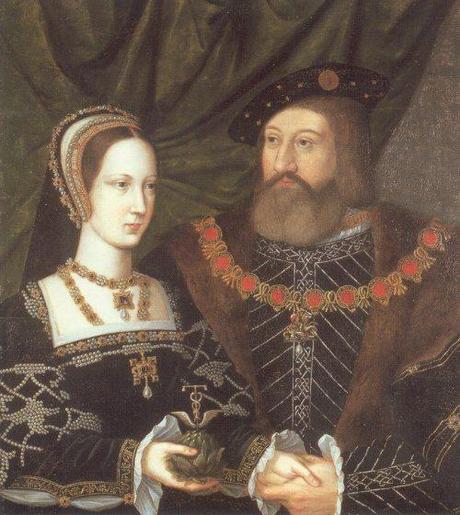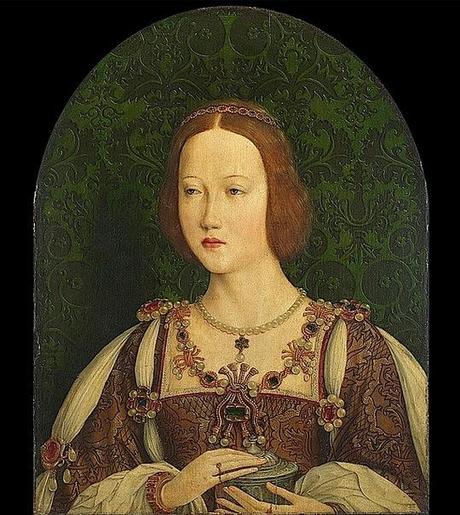
Mary Tudor, Queen of France, unknown artist. Photo: Musée Carnavalet, Paris.
The thing about princesses is that they are rarely even nearly so beautiful as Disney and popular imagination would lead one to believe. It’s funny isn’t it? You hear the word ‘princess’ and the image of a sweetly, winsomely smiling, probably blonde vision of loveliness pops into your mind. I’ve just about trained myself out of this assumption but it some traces of it linger on, despite the fact that I know full well that thanks to centuries of in-breeding, princesses are actually more likely than not to be pretty unattractive creatures…
Not so in the case of Princess Mary Tudor, who was born on the 18th March 1496, the youngest daughter of Henry VII and Elizabeth of York, who inherited her father’s auburn colouring and the delicate loveliness of her mother and fabled grandmother, that astonishing and radiant beauty, Elizabeth Woodville. The offspring of Henry and Elizabeth were pretty fortunate when it came to genetics really as they definitely benefited from the tall, golden haired handsomeness of their grandfather, Edward IV and his beautiful queen. Mary’s older sister, Margaret was also a bit of a looker, as were her brothers Arthur and Henry.

The family of Henry VII and Elizabeth of York, c1503-9. Photo: Royal Collection Trust/© Her Majesty Queen Elizabeth II 2014.
Of course, one can’t be a beautiful princess and not be beset by suitors! As a little girl, Mary was betrothed to her sister in law Catherine’s nephew, Charles of Castile and would have been Empress eventually if the match had ever happened, which alas (or perhaps fortunately?) it did not.
In the end, Mary was married to King Louis XI of France on the 9th of October 1514. The pale and resigned ‘tall, slender, grey-eyed, possessing an extreme pallor‘ bride was eighteen, while her clearly enamoured groom was a rather more mature fifty two. As might be expected, the court of France was delighted to welcome not just a beauteous new Queen but also her bevy of charming and flirtatious maids of honour, all English girls keen to soak up as much Parisian fashion and je ne sais quoi as possible.
However, unknown to her new husband, the new pretty English Queen is said to have harboured a secret love for her brother Henry’s best friend, Charles Brandon, who had already been married twice and then engaged to marry someone else. It’s hard to see from his portraits what on earth she saw in him but allegedly their mutual passion was enough for her brother to not only use Brandon as a bargaining tool when trying to persuade his sister into an unwelcome marriage with Louis (‘Look, if you marry the old French bloke then I absolutely promise that as soon as he croaks, which won’t be long let’s face it, you can marry Brandon. It’s the least I can do after all.’) but also make Charles promise not to propose to her when he was despatched to Paris to bring her back after her husband’s death.
Poor King Louis didn’t live very long after his wedding day and died less than three months later on New Year’s Day 1515, to be succeeded by his son-in-law François I.

Mary Tudor, Queen of France, c1514. Photo: Ashmolean Museum, Oxford.
One can imagine Mary’s feelings at this time, just two months shy of her nineteenth birthday she must have felt both profound relief that she was free once more and also embarrassment when it didn’t take long for court gossip to slyly suggest that her husband had expired after wearing himself out entertaining her in the royal bedchamber.
Then again, the Tudors were not exactly renowned for their finer feelings (Henry VIII always strikes me as the sort of man who reuses his lines on all his women – I can just imagine Jane Seymour rolling her eyes knowingly when she got a letter sighing longingly about ‘kissing your pretty duckies’) so maybe she didn’t care. As was traditional for a French Queen in mourning, she entered a state of seclusion for six weeks at the Hôtel de Cluny in Paris, there to be watched in case she showed signs of a pregnancy that could knock François off the top perch.
The poor young Queen, bored, lonely and probably apprehensive about a future that no doubt contained more unpleasant dynastic matches probably hailed Charles Brandon as a rescuing hero when he turned up at the Hôtel de Cluny to bring her back to England again. She had already written to her brother: ‘Sir, I beseech your grace that you will keep all the promises that you promised me when I took my leave of you by the waterside. Sir, your grace knoweth well that I did marry for your pleasure at this time and now I trust you will suffer me to marry as me liketh for to do… wherefore I beseech your grace for to be a good lord and brother unto me’. Her meaning was clear – I did as you ordered and now I want to be able to as I please OR ELSE.
Of course, every good romance needs a good fairy to help things along a bit and in this case, the fairy comes in the unlikely figure of François I, who was very unwilling to see Mary used as a pawn to secure an alliance between England and the Hapsburgs and so was keen to marry her off to someone of his own choosing. The revelation that his lovely step mother in law was madly in love with Charles Brandon was a godsend and François appears to have exerted himself to bring the marriage about.
Charles must have been torn between loyalty to his King and friend, Henry and his love for Mary but as we all know, Paris is the city of lovers and this, combined with the appeal of the tearful, helpless widowed French Queen, appears to have sealed his fate. He and Mary were married in secret in the Chapel at the Hôtel de Cluny on the 3rd of March 1515 and François gleefully waved them off back to England shortly afterwards, probably caught between tremulous excitement and terror at what Henry’s reaction would be to their news. Optimistically, they had paved the way by writing to Wolsey to let him know, probably in the hopes that they could count on his support but then again, how angry could Henry be? His best friend and his favorite sister? Surely he’d be thrilled beyond belief!

Mary Tudor and Charles Brandon, unknown artist, c1516. Photo: Woburn Abbey.
Henry was furious. How could Mary have thought he was serious with his stupid promise before she set sail for France? What sort of an idiot was Charles to have not only proposed marriage to the sister of his King but also have married her in secret? What sort of reaction were they expecting?! The Privy Council called for Brandon to be arrested and then executed for such terrible lèse majesté but in the end Henry consoled his hurt feelings by demanding repayment of Mary’s dowry (a vast sum) and also appropriating all of the sumptuous plate and jewels that she had accumulated while Queen of France and of which François had nobly allowed her to keep a part. In fact much of the debate, shows of annoyance and wrangling seems to have been focussed on Mary’s possessions rather than Mary herself…
In actual terms though, Henry’s reaction was probably not quite so bad as it could have been. He was hurt that they had both so flagrantly gone against his wishes and probably also vexed when he learned of François’ part in the romance but beyond that he seems to have been resigned to the marriage and even presided, along with Queen Catherine of Aragon, over Mary and Charles’ second official wedding at Greenwich Palace on the 13th of May 1515, giving an outward show of fond brotherly delight and bonhomie.
After her marriage, Mary, now Duchess of Suffolk retired to Brandon’s seat, Westhorpe Hall in Suffolk, although she made regular trips back to court or London, where she resided at Suffolk Place in Southwark, where she maintained a close friendship with her sister-in-law, Catherine of Aragon. Mostly though, she seems to have been content to disappear into comfortable obscurity and assume the rôle of well behaved aristocratic wife and mother, overseeing the expensive expansion of Westhorpe Hall and bearing her husband four children: Henry, born in 1516; Frances, born in 1517; Eleanor, born in 1519 and another Henry, born in 1523. Sadly, only Mary’s daughters would survive into adulthood, with Frances, who became Marchioness of Dorset, eventually becoming mother to Ladies Jane, Catherine and Mary Grey, while Eleanor became Countess of Cumberland and mother to another, much more discreet, contender for the throne, Lady Margaret Clifford.
Although Mary had been waited on by the Boleyn sisters in France and, indeed, Anne Boleyn herself had acted as a proxy god-mother for Queen Catherine and Princess Mary at the christening of Mary’s eldest daughter, Frances in 1517, she completely took her sister-in-law, Catherine’s side when it came to The King’s Great Matter and made her disapproval of the parvenu (ignoring the no doubt unpalatable fact that the Tudors weren’t exactly an ‘old’ family themselves) and flashy Anne Boleyn very clear, which of course had the effect of souring her own relationship with her infatuated brother. It’s not really clear what Mary’s problem with Anne was but it was most likely down to that usual potent brew of feminine jealousy, snobbery and a determination to show sisterly solidarity towards poor beleaguered Catherine. It wouldn’t have been so bad if the whole matter had been restricted to Mary pretending to be ill so that she wouldn’t have to spend time with Anne or making a few barbed comments but instead it all took a rather more serious turn when a violent brawl broke out between the gentlemen of Anne’s uncle, the Duke of Norfolk and those of Mary’s husband, the Duke of Suffolk, which ended in one of the latter gentlemen being killed while attempting to seek sanctuary in Westminster Abbey. It was later found that the whole matter occurred because of ‘opprobrious language uttered against Madame Anne by his Majesty’s sister, the Duchess of Suffolk, Queen Dowager of France.’ Oops.

Mary Tudor, Queen of France, unknown artist, c1514.
However, Mary herself was to survive just one month after Anne Boleyn’s supreme triumph, her Coronation in May 1533, after which, as we know, her career began its every quickening downward spiral into disaster. I don’t think, to be honest, that Mary would have rejoiced at Anne’s downfall – she was as selfish, egotistical and stubborn as the rest of her family but there’s a lightness and humanity in her letters that makes me think that she would have been appalled by her brother’s later behavior.
Sadly though, we will never really know how she would have reacted as she died on the 25th of June, still hailed by all as Queen of France and accorded great honor during her interment at the abbey in Bury St Edmund’s, where she remained until the Dissolution of the Monasteries. Her grieving widower, would marry his fourteen year old ward and their son’s fiancée, Catherine Willoughby, just three months after Mary’s funeral, at which she had been one of the chief mourners.
******
‘Frothy, light hearted, gorgeous. The perfect summer read.’ Minette, my young adult novel of 17th century posh doom and intrigue is now £2.02 from Amazon UK and $2.99 from Amazon US.
Blood Sisters, my novel of posh doom and iniquity during the French Revolution is just a fiver (offer is UK only sorry!) right now! Just use the clicky box on my blog sidebar to order your copy!
Follow me on Instagram.
